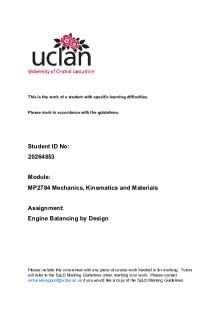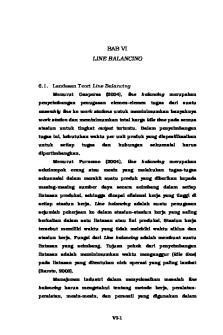Static and Dynamic Balancing PDF

| Title | Static and Dynamic Balancing |
|---|---|
| Course | Engineering dynamics |
| Institution | National University of Sciences and Technology |
| Pages | 5 |
| File Size | 208.3 KB |
| File Type | |
| Total Downloads | 1 |
| Total Views | 168 |
Summary
Download Static and Dynamic Balancing PDF
Description
Experiment: Study Static and Dynamic Balancing Objective:
The object of the experiments is to show static and dynamic balance
Apparatus Description: The apparatus consists of a shaft driven by speed electric motor. The shaft has four balan which can be clamped at any angular and axia The balance blocks can have additional weight in them to vary their weight. The shaft has scale and pointer, also a linear scale is fit chassis below the shaft. Weights can be adjust as well as in circular arrangement using these s Figure 1: Static and Dynamic Balancing Apparatus
Theory: Introduction: The balancing of rotating machinery is a common problem in engineering that requires a solution. Balanced machines are quiet and impose a minimal load on the machine elements and their surroundings. This has the economic benefits of reducing the costs of both manufacture and operation of the machine. In certain cases unless a machine is quiet, its operation may not be tolerable or even permitted. In real life though parts may be made to very high accuracies, none are ever perfect. Thus parts which should have their centre of gravity on the axis of rotation are often slightly eccentric. Sometimes this eccentricity and the out of balance forces can be ignored. However it is usually necessary to determine the position and magnitude of the out of balance force so that it may be corrected. Then material may be either added to or removed from the part to compensate and reduce the dynamic force to within an acceptable limit.
The eccentricity, e, is defined a distance between the centre of rotation and the centre of gravity. Unbalance refers to the center-ofgravity of the rotor being out of alignment with its center-of-rotation (eccentricity). If unbalanced, centrifugal forces will generate vibration and noise during rotation. A common example is the lead weight attached to the rim of a car wheel to balance it. The weight is to compensate for the valve assembly and also the manufacturing differences in the wheel and tyre.
Balancing Consider a rigid shaft rotating in bearings. The shaft carries masses
m1...n
and radii r1...n and at axial distances z1...n from a fixed datum. Balance is achieved by:(i) Taking moments about the axis of rotation, such that the summation is equal to zero and (ii) Taking moments about the fixed datum, such that the summation is equal to zero
(i)
Σ mn rn = 0
and
(ii)
Σ mn rn zn = 0
for n = 1 to n = n. Static balance is achieved if (i) is satisfied. Dynamic balance is achieved only if both (i) and (ii) are satisfied. Procedure: Experiment One - Simple Static Balance Clamp one block at 25mm and at zero degrees. Look down the face of the block and sight the scale to get the axial position. Rotate the shaft by hand so that the zero is by the cursor. If necessary hold the shaft drive pulley against the bearing block. Position block 2 at 75mm and also at zero degrees. Then rotate the shaft through 180 degrees and position blocks three and four at 125mm and 175mm respectively. Remove the drive belt and gently rotate the shaft by hand and release. You should see that if this is repeated a few times the shaft has no great affinity for stopping at any particular position. Now place the drive belt over the pulleys and fit the guard. Ensure the emergency stop is released and press the green button to apply power to the motor.
Gently and gradually increase the motor speed from rest. Be very careful! As the shaft is only statically balanced, and NOT dynamically balanced; the system will start to vibrate. Thus keep the speed to only 200 or 300 rpm or less, just sufficient to show that the system is dynamically unbalanced. Experiment Two - Simple Dynamic Balance After conducting experiment one, reposition blocks 2 and four as follows. Rotate block 2 so that it is at 180 degrees, i.e. the same as block three. Rotate block 4 so that it is at zero degrees, i.e. the same as block one. Now remove the drive belt and gently rotate the shaft by hand. Again you will see that the shaft has no great affinity for stopping in a specific position. Place the drive belt over the pulleys and fit the guard. Ensure the emergency stop is released and press the green button to apply power to the motor. Gently and gradually increase the motor speed from rest. Observe that the system remains relatively motionless through a wide speed range. Thus the system is now both statically and dynamically balanced.
Conclusion: Q: 1 Why is that even precise manufacturing could not yield perfectly balanced system? Q: 2 Did dynamically balanced system showed any vibration? What is your observation comparing it to statically balanced arrangement? Q: 3 Ideally a dynamically balanced system should not show any vibration. Was your case ideal? Q: 4 What is eccentricity? How does it affect balance of a rotating body?
Note: (For personal understanding: Not to include in lab report)
During the arrangement as shown noise and vibration does originate at higher RPM if not at lower RPM. o Increasing distance between blocks intensify this vibration while reducing distance between blocks make it smooth even at higher RPM. This is because of the fact that distance along Z-axis effects dynamic balancing. For dynamic and static balancing equations mentioned in the theory must satisfy. But how could we consider moments around shaft positive or negative? For this we will use right hand thumb rule. o Consider same arrangement described above
o Side view of this arrangement would be as follows and since C.G. of block weight would be away from center of rotation of shaft so if block is allowed to rotate around shaft freely then under the action of gravity every block will tend to rotate downward. Thus curl your fingers in the direction of rotation and thumb will point out the direction of motion. Set any moment as positive and other block/counter weight will produce opposite moment. By this we can differentiate moments as positive and negative
o In this way we can only satisfy following arrangement.
Apart from initial block every block is 50 mm apart from each other and block 1 is 25mm away from datum. Thus distance from datum: Block 1= 25 mm Block 2 = 75 mm Block 3 = 125 mm Block 4 = 175 mm If moment of block 1 and 4 is considered as positive then: Equation 1:
Σ mn rn = 0 + Mblock1 – Mblock2 – Mblock3 + Mblock4 = 0
Σ mn rn zn = 0 + (Mblock1 x 25) – (Mblock2 x 75) – (Mblock3 x 125) + (Mblock4 x 175) = 0 Since, every block is ideal so net result is zero. In this way we can find out disturbance on the shaft support....
Similar Free PDFs

Static and Dynamic Balancing
- 14 Pages

Static and Dynamic Balancing
- 5 Pages

Static and Dynamic Economics
- 6 Pages

STATIC AND DYNAMIC 10TH EDITION BEER
- 1,397 Pages

Dynamic balancing of a inline engine
- 14 Pages

Static Ram v/s Dynamic RAM
- 5 Pages

Neutral Point and Static Margin
- 1 Pages

Static and Kinetic Friction lab
- 10 Pages

line balancing
- 22 Pages
Popular Institutions
- Tinajero National High School - Annex
- Politeknik Caltex Riau
- Yokohama City University
- SGT University
- University of Al-Qadisiyah
- Divine Word College of Vigan
- Techniek College Rotterdam
- Universidade de Santiago
- Universiti Teknologi MARA Cawangan Johor Kampus Pasir Gudang
- Poltekkes Kemenkes Yogyakarta
- Baguio City National High School
- Colegio san marcos
- preparatoria uno
- Centro de Bachillerato Tecnológico Industrial y de Servicios No. 107
- Dalian Maritime University
- Quang Trung Secondary School
- Colegio Tecnológico en Informática
- Corporación Regional de Educación Superior
- Grupo CEDVA
- Dar Al Uloom University
- Centro de Estudios Preuniversitarios de la Universidad Nacional de Ingeniería
- 上智大学
- Aakash International School, Nuna Majara
- San Felipe Neri Catholic School
- Kang Chiao International School - New Taipei City
- Misamis Occidental National High School
- Institución Educativa Escuela Normal Juan Ladrilleros
- Kolehiyo ng Pantukan
- Batanes State College
- Instituto Continental
- Sekolah Menengah Kejuruan Kesehatan Kaltara (Tarakan)
- Colegio de La Inmaculada Concepcion - Cebu






